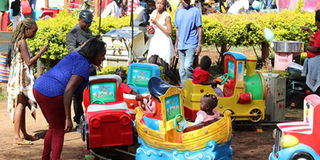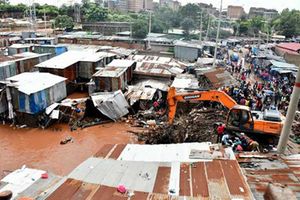Rethink plans to hive off part of Uhuru Park land

Families have memorable moments at Uhuru Park, in Nairobi, on October 21, 2019 during Mashujaa Day celebrations. There are plans to excise the park to create room for an expressway linking JKIA and the Museum Hill interchange in Nairobi. PHOTO | LUCY WANJIRU | NATION MEDIA GROUP
What you need to know:
- Once the responsible managers unclog the existing system, then they can revisit plans for the future. In that planning, monuments like Uhuru Park must be safeguarded.
- It is scandalous that while efforts globally are directed at protecting green spaces, water sources, rivers and wildlife, we are so casual about protecting the little that we have left!
It is inconceivable that the government did not anticipate the outrage that has greeted the announcement that part of Uhuru Park grounds will be hived off to make way for a 27km expressway to link Jomo Kenyatta International Airport and the Museum Hill interchange in Nairobi.
Apart from the intended excision being seen as a callous affront to the memory of Prof Wangari Maathai’s 1980s opposition to the then planned degradation of a scarce natural and priceless resource for a commercial building, the value of the road to the greater society is at best highly contentious.
Most well-planned cities ensure traffic flow into and out of airports is as smooth as possible, but hardly any will consider constructing an expressway primarily to serve an airport, at a cost of about Sh3.7 billion per kilometre.
First, the number of passengers that actually travel to and from the JKIA is a couple of thousands a day and is not expected to grow spectacularly because of impending competition from the expansion of the Dar es Salaam and Entebbe airports, and the planned 2020 opening of the Bugesera International Airport, 25 kilometres from Kigali.
TRAFFIC
Bugesera is planned to handle 1.8 million passengers per year. With world-class conference facilities in Kigali, its fabled reputation for cleanliness and order and the expansion of Rwanda Air, it can be expected many international passengers will see little value of transiting through Nairobi.
No one likes to sit and seethe in stationary traffic. It is not only air travellers in a hurry to reach the airport.
Tens of thousands of commuters are on Mombasa Road every hour (with peaks in the morning and evenings) moving to and from different destinations.
Road planners and traffic coordinators should be concerned about all these people.
There are three things that the planned expressway is not going to solve that are a lot more urgent irritants – the lack of an efficient public transport system; the extraordinarily bad manners of many Kenyan drivers, and the lack of a well-coordinated and enforced traffic flow.
PUBLIC TRANSPORT
It is possible to deal with all three first because they are operational.
Surely, there is sufficient planning and execution capacity between the Transport ministry, the city county government, the rail transport authorities, the police and the Nairobi Metropolitan Area Transport Authority to instil some order and ensure better use of the existing capacity before planning for the next 100 years.
Why, for instance, is it that the Nairobi traffic lights system is never allowed to work without traffic police interfering?
And why is it that when police choose “to help”, particularly on Mombasa Road, cars generally do not move for long periods?
What is being done to ensure better use of the existing rail network in the Nairobi metropolis? When will talk about improving public transport move from being verbal fluff to action on the ground?
There are plenty of well-tested initiatives that can bring some sanity back into the transport system.
CONSERVATION
Once the responsible managers unclog the existing system, then they can revisit plans for the future. In that planning, monuments like Uhuru Park must be safeguarded.
It is scandalous that while efforts globally are directed at protecting green spaces, water sources, rivers and wildlife, we are so casual about protecting the little that we have left!
Granted, existing infrastructure will be expanded. But build on top, under or around the existing facilities to create useful, beautiful and functional utilities that serve human beings, not dehumanise them.
We have seen it in other places where our leaders and planners go to benchmark. Demonstrate that you have learnt something!
Mr Mshindi is the former editor-in-chief of the Nation Group and is now consulting. [email protected], @tmshindi





